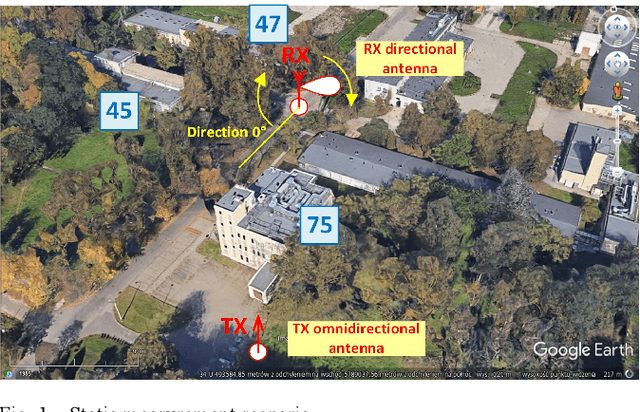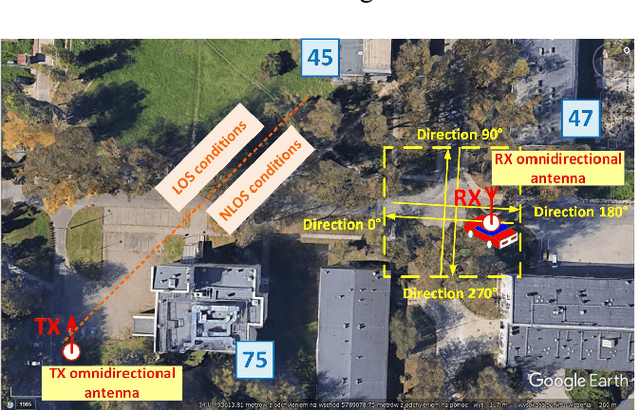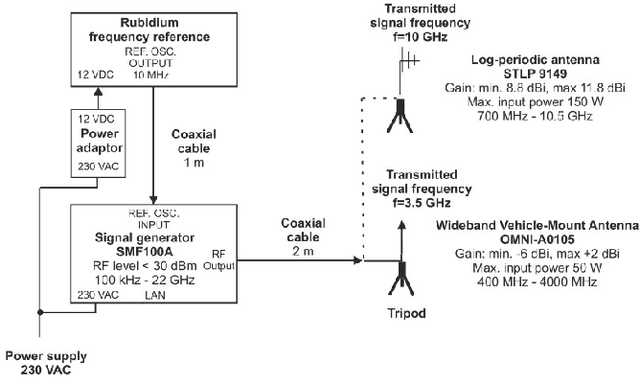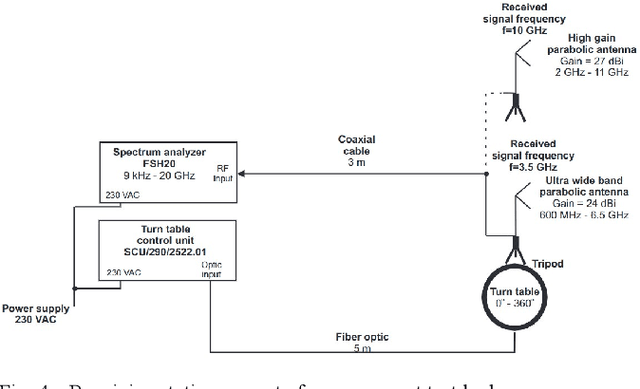Aniruddha Chandra
Channel impulse response peak clustering using neural networks
Mar 26, 2025



Abstract:This paper introduces an approach to process channel sounder data acquired from Channel Impulse Response (CIR) of 60GHz and 80GHz channel sounder systems, through the integration of Long Short-Term Memory (LSTM) Neural Network (NN) and Fully Connected Neural Network (FCNN). The primary goal is to enhance and automate cluster detection within peaks from noised CIR data. The study initially compares the performance of LSTM NN and FCNN across different input sequence lengths. Notably, LSTM surpasses FCNN due to its incorporation of memory cells, which prove beneficial for handling longer series.Additionally, the paper investigates the robustness of LSTM NN through various architectural configurations. The findings suggest that robust neural networks tend to closely mimic the input function, whereas smaller neural networks are better at generalizing trends in time series data, which is desirable for anomaly detection, where function peaks are regarded as anomalies.Finally, the selected LSTM NN is compared with traditional signal filters, including Butterworth, Savitzky-Golay, Bessel/Thomson, and median filters. Visual observations indicate that the most effective methods for peak detection within channel impulse response data are either the LSTM NN or median filter, as they yield similar results.
* 7 pages, 10 figures, 5 tables
Comparative analysis of clustering methods for power delay profile in MMW bands and in-vehicle scenarios
Mar 26, 2025Abstract:The spatial statistics of radio wave propagation in specific environments and scenarios, as well as being able to recognize important signal components, are prerequisites for dependable connectivity. There are several reasons why in-vehicle communication is unique, including safety considerations and vehicle-to-vehicle/infrastructure communication.The paper examines the characteristics of clustering power delay profiles to investigate in-vehicle communication. It has been demonstrated that the Saleh-Valenzuela channel model can also be adapted for in-vehicle communication, and that the signal is received in clusters with exponential decay. A measurement campaign was conducted, capturing the power delay profile inside the vehicle cabin, and the reweighted l1 minimization method was compared with the traditional k-means clustering techniques.
* 6 pages, 10 figures
Channel modeling for 60 GHz fixed mmWave O2I and O2O uplink with angular misalignment
Mar 24, 2025Abstract:In this letter, we examine the effect of misalignment angle on cluster-based power delay profile (PDP) modeling for a 60 GHz millimeter-wave uplink. The analysis uses real-world data, where fixed uplink scenarios are realized by placing the transmitter at ground level and the receiver at the building level. Both outdoor-to-indoor (O2I) and outdoor-to-outdoor (O2O) scenarios are studied. Using the misalignment angle and the scenario as inputs, we propose a statistical PDP simulation algorithm based on the Saleh-Valenzuela model. Different goodness-of-fit metrics reveal that our proposed algorithm is robust to both O2I and O2O scenarios and can approximate the PDPs fairly well, even in case of misalignment.
* 5 pages, 4 figures, 4 tables
Long-term channel analysis at 60 and 80 GHz for autonomous ground vehicles
Mar 24, 2025Abstract:This paper presents a comprehensive measurement campaign aimed at evaluating indoor-to-indoor radio channels in dynamic scenarios, with a particular focus on applications such as autonomous ground vehicles (AGV). These scenarios are characterized by the height of the antennas, addressing the unique challenges of near-ground communication. Our study involves long-term measurements (20 minutes of continuous recording per measurement) of the channel impulse response (CIR) in the 60 GHz and 80 GHz frequency bands, each with a bandwidth of 2.048 GHz. We investigate the variations in channel characteristics, focusing on parameters such as root mean square (RMS) delay spread and the Rician factor.
* 6 pages, 9 figures, 2 tables
Vehicle to vehicle path loss modeling at millimeter wave band for crossing cars
Mar 24, 2025Abstract:Fifth generation (5G) new radio is now offering sidelink capability, which allows direct vehicle-to-vehicle (V2V) communication. Millimeter wave (mmWave) enables low-latency mission-critical V2V communications, such as forward crash warning, between two vehicles crossing on a road without dividers. In this article, we present a measurement-based path loss (PL) model for V2V links operating at 59.6 GHz mmWave when two vehicles approach from opposite sides and cross each other. Our model outperforms other existing PL models and can reliably model both approaching and departing vehicle scenarios.
* 5 pages, 4 figures, 2 tables
Synthesis of omnidirectional path loss model based on directional model and multi-elliptical geometry
Mar 18, 2025



Abstract:Millimeter wave (mmWave) technology offers high throughput but has a limited radio range, necessitating the use of directional antennas or beamforming systems such as massive MIMO. Path loss (PL) models using narrow-beam antennas are known as directional models, while those using omnidirectional antennas are referred to as omnidirectional models. To standardize the analysis, omnidirectional PL models for mmWave ranges have been introduced, including TR 38.901 by 3GPP, which is based on measurements from directional antennas. However, synthesizing these measurements can be complex and time-consuming. This study proposes a numerical approach to derive an omnidirectional model from directional data using multi-elliptical geometry. We assessed the effectiveness of this method against existing PL models for mmWaves that are available in the literature.
* 5 pages, 5 figures, 2 tables, 1 algorithm, 10 equations
Spectral efficiency for mmWave downlink with beam misalignment in urban macro scenario
Mar 16, 2025Abstract:In this paper, we analyze the spectral efficiency for millimeter wave downlink with beam misalignment in urban macro scenario. For this purpose, we use a new approach based on the modified Shannon formula, which considers the propagation environment and antenna system coefficients. These factors are determined based on a multi-ellipsoidal propagation model. The obtained results show that under non-line-of-sight conditions, the appropriate selection of the antenna beam orientation may increase the spectral efficiency in relation to the direct line to a user.
* 4 pages, 6 figures, 4 equations; 2024 4th URSI Atlantic Radio Science Meeting (ATRASC), Meloneras, Spain, 19-24 May 2024
Power angular spectrum versus Doppler spectrum -- Measurements and analysis
Mar 16, 2025



Abstract:In this paper, we present an empirical verification of the method of determining the Doppler spectrum (DS) from the power angular spectrum (PAS). Measurements were made for the frequency of 3.5 GHz, under non-line-of-sight conditions in suburban areas characteristic of a university campus. In the static scenario, the measured PAS was the basis for the determination of DSs, which were compared with the DSs measured in the mobile scenario. The obtained results show that the proposed method gives some approximation to DS determined with the classic methods used so far.
* 5 pages, 7 figures, 1 table, 8 equations; 2023 17th European Conference on Antennas and Propagation (EuCAP), Florence, Italy, 26-31 Mar. 2023
Variability of radio signal attenuation by single deciduous tree versus reception angle at 80 GHz
Mar 16, 2025



Abstract:Vegetation significantly affects radio signal attenuation, influenced by factors such as signal frequency, plant species, and foliage density. Existing attenuation models typically address specific scenarios, like single trees, rows of trees, or green spaces, with the ITU-R P.833 recommendation being a widely recognized standard. Most assessments for single trees focus on the primary radiation direction of the transmitting antenna. This paper introduces a novel approach to evaluating radio signal scattering by a single deciduous tree. Through measurements at 80 GHz and a bandwidth of approximately 2 GHz, we analyze how total signal attenuation varies with the reception angle relative to the transmitter-tree axis. The findings from various directional measurements contribute to a comprehensive attenuation model applicable to any reception angle and also highlight the impact of bandwidth on the received signal level.
* 5 pages, 5 figures, 1 table, 7 equations; 2025 19th European Conference on Antennas and Propagation (EuCAP), Stockholm, Sweden, 30 Mar.-4 Apr. 2025
Site-Specific Radio Channel Representation -- Current State and Future Applications
Jun 18, 2024



Abstract:A site-specific radio channel representation considers the surroundings of the communication system through the environment geometry, such as buildings, vegetation, and mobile objects including their material and surface properties. In this article, we focus on communication technologies for 5G and beyond that are increasingly able to exploit the specific environment geometry for both communication and sensing. We present methods for a site-specific radio channel representation that is spatially consistent, such that mobile transmitter and receveiver cause a correlated time-varying channel impulse response. When modelled as random, this channel impulse response has non-stationary statistical properties, i.e., a time-variant Doppler spectrum, power delay profile, K-factor and spatial correlation. A site-specific radio channel representation will enable research into emerging 5G and beyond technologies such as distributed multiple-input multiple-output systems, reconfigurable intelligent surfaces, multi-band communication, and joint communication and sensing. These 5G and beyond technologies will be deployed for a wide range of environments, from dense urban areas to railways, road transportation, industrial automation, and unmanned aerial vehicles.
 Add to Chrome
Add to Chrome Add to Firefox
Add to Firefox Add to Edge
Add to Edge